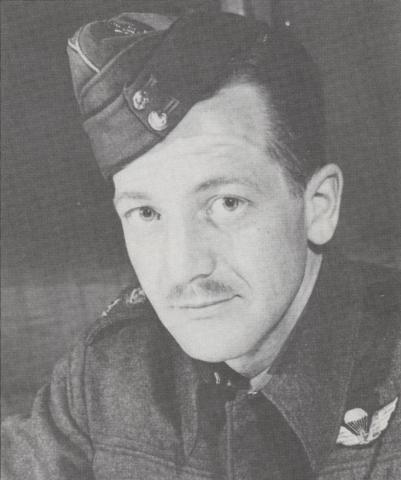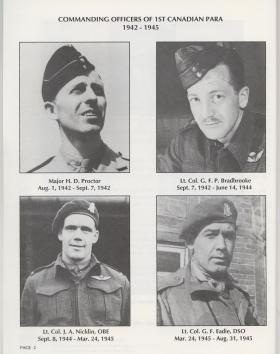Lieutenant Colonel George Frederick Preston Bradbrooke was a Commanding Officer of the 1st Canadian Parachute Battalion.
In peactime he was an accountant for a farm implement company in Regina, Canada. At the outbreak of war, however, he joined the Saskatoon Light Infantry and by 1942 had already taken part in the Spitzbergen raid (Operation Gauntlet) and visited Russia. At the age of 30 he was reportedly the youngest Lieutenant Colonel in the Canadian Army. Bradbrooke, who was six foot one, was described as "every inch a 1930s matinee idol and sometimes acted like one, in the memory of some of the men". The historian Dr Bernd Horn suggests on the basis of interviews that, "many of his soldiers found him aloof, if not socially elitist". Lieutenant William Jenkins stated that he "relied on his rank", whilst Private Doug Morrison described him as "a good administrator, but he wasn't a field soldier". On the other hand, the Battalion was in desperate need of competent administration in its early days.
Major Hilton David Proctor, the first CO of the 1st Canadian Parachute Battalion, was involved in a fatal parachuting accident on September 7, 1942 at Fort Benning in Georgia. Bradbrooke was therefore made a Lieutenant Colonel on 12 October 1942, becoming the 1st Battalion's CO on the same day. He was posted to Fort Benning on October 28. Bradbrooke quickly made his intentions known, declaring "skill and efficiency in the handling of all weapons...must reach and will reach a higher standard than any other arm of the service".
In a letter held in the National Archives of Canada from November 8, 1942, Bradbrooke stated his desire for the Canadians' beret to be dark green. This would match the backing of their jump wings, which were distinct from the British. Bradbrooke was informed on November 11 that the Canadians had decided to adopt the maroon beret instead. Colonel R.W. Keefler raised the issue again on November 16, arguing for the dark green beret. But a Brigadier Ernest Weeks ended the discussion with the statement, "if we copy someone in the matter of uniforms it should be the British in preference to the U.S.A.".
From December 1942 to February 1943, Bradbrooke worked to improve the Battalion's morale to prevent its men being poached by other units, with 97 having already left. His changes helped to improve the structure, equipment and organisation of the unit, such that the War Diary notes "Operation of the Battalion is becoming more efficient every day...morale has improved tremendously". However, Bradbrooke was not known for his skills as a disciplinarian, with Corporal John Ross opining that he was "over his head". Dr Horn suggests that Bradbrooke relied on his deputy Jevon Nicklin to "swing the big stick". But Lt. William Jenkins replied that Nicklin was himself multifaceted, writing, "I agree Jeff was strict and tough, but that was only one side of him".
Whilst Bradbrooke initially had a reputation as an administrator, he proved his mettle on D-Day by dropping into combat with his men. As with many night operations, Operation Tonga had been a highly chaotic and by some accounts disastrous drop, with only a third of the Canadians arriving at their pre-determined rendezvous points. Bradbrooke's HQ was scattered and he himself recalled, "I personally was dropped a couple of miles away from the drop zone in a marsh near the River Dives and arrived at the rendezvous about one and a half hours late and completely soaked". Fortunately, his stick "were not troubled by the enemy at this time, I suppose he [the enemy] was just as confused as we were...The hardest part of the job wasn’t the fighting, although that was hard enough at times, but getting ourselves organized after we hit the DZ".
Bradbrooke credited the Battalion's rigorous training in the eventual achievement of its objectives on D-Day, "dropping at night, several hours before the seaborne assault, in strange and hostile territory, all added up to confusion and an appreciation of the reasons why prior training of such severity was necessary". However, he lamented the fact that his men were cut off from the main invasion force for so long, describing them as "just one little pocket on the end of nowhere".
Although he had been part of the drop, a perception remained after Normandy that Bradbrooke "was no active commander - he should have been assigned to a desk" (Sergeant John Feduck). Brigader Hill told Bradbrooke's deputy, Fraser Eadie, to stay with him as "he's a bit nervous". Hill's assessment that Bradbrooke was "a good administrator, a very good CO in peactime and an intrepid parachutist" appears to subtly imply that he was not suited to the frontlines. Major Richard Hilborn opined that Hill spent a disproportionate amount of time leading the Canadians as a result, even after Hill was himself injured. Hilborn claims to have personally appealed to Lieutenant General Ken Stuart to get Bradbrooke reassigned to the general staff, saving Hill a political headache. Coincidentally, Ken Stuart visited the Battalion on August 23.
Whatever the case, on August 23, 1944 (the same day), Bradbrooke returned to England to take a position on the general staff of the Canadian Military Headquarters, being replaced on an interim basis as the Canadians' CO by G.F. Eadie. The position was then taken over by Jeff Nicklin permanently from September 8 until his untimely death in 1945.
Compiled with information from:
Airborne Assault Archive (Boxes 3 F2 3.17.1, 3 F2 3.17.2 and 3 F2 3.17.3)
'The bitter fight to hold Juno Beach', https://www.espritdecorps.ca/history-feature/the-bitter-fight-to-hold-juno-beach-canadians-in-normandy-june-1944-part-one, Mark Zuehlke
"A Most Irrevocable Step: Canadian Paratroopers on D-Day, The first 24 hours, 5-6 June 1944.", Bernd Horn and Michel Wyczynski Canadian Military History 13, 3 (2004)
'Canadian War Museum's Airborne Beret Collection', Michel Wyczynski, https://journals.lib.unb.ca/index.php/MCR/article/download/17868/22087?inline=1#no9
'Bradbrooke, Nicklin and Eadie: A Tale of Command', Bernd Horn in Intrepid Warriors: Perspectives on Canadian Military Leaders (Kingston, 2007), (ed.) Bernd Horn, pp. 223-247
The Maroon Beret, summer 2008
Article written by Alex Walker
Read More


Latest Comments
There are currently no comments for this content.
Add Comment
In order to add comments you must be registered with ParaData.
If you are currently a ParaData member please login.
If you are not currently a ParaData member but wish to get involved please register.